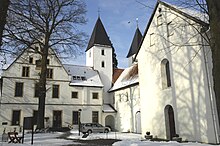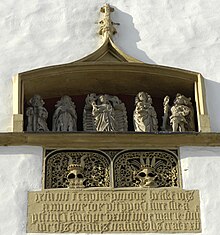Cappel pen
The Cappel Abbey in Cappel , today a district of Lippstadt , was a women's convent that lived according to the Constitutions of the Premonstratensians . In the 16th century it was converted into a free world, evangelical women's monastery.
history
Premonstratensian pen
In Cappel a chapel was supposedly donated by Charlemagne after a battle against the Saxons . There is evidence of a chapel that also served as a parish church from a later period. This building was partially integrated into the later collegiate church.
The exact circumstances in which the monastery was founded are not known. There are opinions that assume that it was founded before 1139. It is likely that it was founded around 1140. The first document, however, dates from 1196. It is possible that the first women were displaced from the Liesborn monastery . Cappel was under the patronage of Maria and Andreas .
Probably proven from the beginning, but it did not follow the customs of the Premonstratensians until the 13th century. It was closely connected with the noble lords of the Lippe . These and other nobles donated considerable property to the monastery for equipment and supplies. At first the monastery belonged to the diocese of Münster . Due to a papal decision, the Archdiocese of Cologne came to be . At the same time, Cappel was removed from the parish of Liesborn . The clergy belonging to the monastery took over the pastoral care of the parish. In 1280 the abbot von Knechtsteden and the provost von Wedinghausen visited the monastery. In 1316 the Archbishop of Cologne had monastic discipline restored.
Among the female inmates there was a prioress, a subprioress, a waitress and a chamberlain. Male members were a provost, a prior, a chaplain, a chamberlain, various "fratres", "conversi" and "familiares".
After the Reformation
After the noble lords of the Lippe had become Protestant, from 1571 onwards the monastery was transformed into a free worldly Protestant ladies' monastery in several steps. In 1577 or 1578 the last Catholic provost had to leave the monastery. In 1588 it was officially converted into a Protestant women's monastery. Later counter-Reformation approaches by the Abbot von Knechtsteden in 1623 and 1633 failed. Since 1633, the continued existence of the Protestant monastery was now secured under an abbess from the house of the noble lords or counts of Lippe. In 1794 the monastery was sacked by French troops.
From 1618, the monastery was managed by an abbess, who was assisted by a "vice domina" and a dean. A bailiff can be proven from 1588. In addition, there were clerks, syndicates, lawyers, administrators, renters, bailiffs, sextons, porters and an evangelical preacher. There were 10 prebends , with the canonesses mainly coming from Protestant areas of northern and central Germany. The number of positions was expanded to 21 in the 19th century. From now on, descendants from civil servant and military families could also be accepted, although they had to come from the state of Lippe.
The Catholic Church officially dissolved the monastery in 1639. As early as 1577, the last Catholic provost had moved to Eikeloh near Erwitte with some canons . The Catholic monastery tradition of Cappel was continued in the Propstei Eikeloh until the community died out in 1659. The provosts, who were employed by the Knechtsteden Abbey, administered the facility and the assets of the Cappel monastery located in the Duchy of Westphalia . The provost's office was dissolved in 1804 in the course of secularization .
The Protestant women's monastery itself existed until 1971. After that, it was united by state law with the St. Marien monastery in Lemgo. The pen tradition continues indirectly, albeit elsewhere.
Buildings and equipment
The west building with the two towers was built in the middle of the 12th century. The vestibule is richly structured. Above her is the former gallery of the nuns. The nave was later added to the west building. This created a Romanesque pillar basilica by the end of the 12th century . Part of the side aisles and apses were demolished before 1691. Restorations took place in the 19th century and in the 1950s. In the course of the fundamental restoration between 1976 and 1980, later additions and modifications were removed and the original state of construction was essentially restored.
In the church there is a two-tier baptismal font that probably dates from the time the monastery was built. The vault painting from around 1250 is also remarkable. The tabernacle, pulpit and lectern date from the 15th century. The choir stalls date from the 16th century. In the church there are tombstones of abbesses and canonesses. These date from the period between the 16th and 19th centuries. In the church there are also five late Gothic figures of saints, which used to be attached to the gable of the monastery.
The chapter house and the abbess' building from the 16th century have also been preserved. A canons' house and the half-timbered dean's house date from the 18th century.
Parts of the monastery building are used by an evangelical vocational school as "Cappel Abbey - Vocational College"
Bells
The north tower carries the peal of three bronze bells on the top floor:
| No. | Nominal | Weight | diameter | Casting year | Caster | inscription |
|---|---|---|---|---|---|---|
| 1 | H' | 281 kg | 774 mm | 1970 | Rincker / Sinn | COME HERE, LET US CURLS TO THE LORD! |
| 2 | cis '' | 130 kg | 630 mm | 1802 | BH Fricke / Gütersloh | CCGVE FRAU z LIPPE, ABTESS z CAPPEL u LEMGO A. RÖTTECKEN BH FRICKE GLOKKENGIESSER 1802. |
| 3 | e '' | 111 kg | 570 mm | 1970 | Rincker / Sinn | JESUS CHRIST YESTERDAY AND TODAY AND THE SAME IN ETERNITY. |
Prioresses and abbesses
- 1280/1282 Cunegundis
- 1306 Christine
- 1338 Oda
- 1465/1504 Agnes von Walstede
- 1498 Gertrud von Königsberg
- 1504 Alke (or Adelheid) from Warendorp
- 1512 Katharina tor Aune
- 1513 Anna Torck
- 1546 Anna Westphal
- 1556 Rolich von der Recke
- 1577–1578 / 1588 Margarethe von Erwitte
- 1588/1591 Anna Vogt von Elspe
- 1591/1594 Margarethe von Bredenol
- 1604 Catharina von Rump
- 1611/1619 Sophia von Oer
- 1619–1628 Anna Catharina von Ovelacker
Abbesses from the House of Lippe:
- 1628–1629 Juliane Ursula
- 1629–1657 Anna Katharina
- 1657–1690 Anna Maria
- 1690-1707 Albertine
- 1707–1751 Amalie Luise Wilhelmine
- 1751–1793 Elisabeth Henriette Amalie
- 1793-1804 Charlotte Clementine
- 1804–1826 Auguste Henriette Casimire Wilhelmine
- 1826–1887 Christine Luise Auguste Charlotte
- 1887-1906 Pauline
- 1907 Caroline
- 1927 Lilli
Management of the monastery by deans:
- 1906–1919 Lucie von Rheden
- 1919–1971 Else Dirking
literature
- Rainer Brücker: The denominational development in Westphalia in the 17th century . Diss. Duisburg 2003 ( University of Münster )
- Paul Eickhoff: Cappel, the Westphalian cultural gem - a church and monastery founded by the Premonstratensian order in the important Staufer period of the 12th century , Lippstadt-Cappel 1977
- Karl Hengst (Ed.): Westphalian monastery book. Part 1: Ahlen - Mülheim. Aschendorff, Münster 1992, ISBN 3-402-06886-9 , pp. 167–172, ( sources and research on the history of church and religion 2, publications of the Historical Commission for Westphalia 44)
- Ingeborg Kittel: The Cappel Abbey in the Thirty Years' War - the dispute with the Knechtsteden Abbey , in: Lippische Mitteilungen, Vol. 41 (1972), pp. 108-143
- Schelhasse: Stift Cappel and Probstei Eikeloh , in: Journal for patriotic history and antiquity, vol. 63, dept. 2 (1905), pp. 63–81
- Manfred Schneider: Cappel Abbey ( Westfälische Kunststätten , issue 35). Munster 1984
- R. Stegmann: Documents of the Cappel Monastery , in: Lippische Mitteilungen, Vol. 4 (1906), pp. 190–192
Web links
- Document requests from the State Archive of North Rhine-Westphalia on the Cappel Abbey / digital Westphalian document database (DWUD)
- Information on the inventory of documents A 41 I - Stift Cappel (documents) of the Westphalia department of the State Archive of North Rhine-Westphalia
- Information on the files L 35 - Amt Lipperode and Stift Cappel (files) of the department Ostwestfalen-Lippe of the Landesarchiv NRW
- Information on the files L 110 A - Stift Cappel (deposit) of the East Westphalia-Lippe department of the North Rhine-Westphalia State Archives
- Entry in travel guide for the Premonstratensian Order
- Brief description ( Memento from December 30, 2007 in the Internet Archive )
- Brief description with pictures
Individual evidence
- ↑ Ev. Parish of Lippstadt: Cappel Abbey . Ed .: Ev. Lippstadt parish. Lippstadt 1997, p. 21 .
- ↑ State Archives North Rhine-Westphalia, East Westphalia-Lippe Department, File L 35 No. 77
Coordinates: 51 ° 40 ′ 54.1 ″ N , 8 ° 17 ′ 50.9 ″ E




